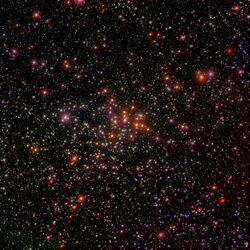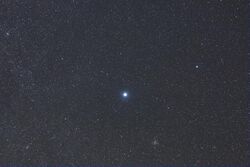Astronomy:NGC 2360
| NGC 2360 | |
|---|---|
 | |
| Observation data (J2000 epoch) | |
| Constellation | Canis Major |
| Right ascension | 07h 17m 43s[1] |
| Declination | −15° 38′ 29″[1] |
| Apparent magnitude (V) | 7.2[2] |
| Apparent dimensions (V) | 13′[2] |
| Physical characteristics | |
| Other designations | Caroline's Cluster,[3] Caldwell 58, Cr 134, Mel 64[3] |

NGC 2360 (also known as Caroline's Cluster[3] or Caldwell 58) is an open cluster in the constellation Canis Major. It was discovered on 26 February 1783[4] by Caroline Herschel, who described it as a "beautiful cluster of pretty compressed stars near 1/2 degree in diameter".[5] Her notes were overlooked until her brother William included the cluster in his 1786 catalogue of 1000 clusters and nebulae and acknowledged her as the discoverer.[4] The cluster lies 3.5 degrees east of Gamma Canis Majoris and less than one degree northwest of the eclipsing binary star R Canis Majoris; it has a combined apparent magnitude of 7.2.[5] It is 13 arc minutes in diameter.[2] By the western edge of the cluster is the unrelated star, 5.5-magnitude HD 56405.[6]
American astronomer Olin J. Eggen surveyed the cluster in 1968, concluding that the brightest star in the field, magnitude-8.96 HD 56847, is likely to lie in the field and not a true member of the cluster. He also identified one or possibly two blue stragglers.[7] These are unexpectedly hot and luminous stars that appear younger than surrounding stars, and have likely developed by sucking matter off companion stars.[8] Four are now recognised to be in the cluster.[9] By analysing the masses of the smallest stars that have evolved into red giants—namely, stars of 1.8 or 1.9 solar masses—Swiss astronomers Jean-Claude Mermilliod and Michel Mayor were able to date the age of the cluster at 2.2 billion years.[10] The cluster has a diameter of around 15 light-years and is located 3700 light-years from Earth.[5]
 Sirius and M41 (lower right), M50 (upper left), and NGC 2360 (lower left) |
Notes
- ↑ 1.0 1.1 "Results for NGC 2360". NGC/IC Project Database. http://www.ngcicproject.org/ngcicdb.asp.
- ↑ 2.0 2.1 2.2 "SEDS Online NGC Database". Results for NGC 2360. http://spider.seds.org/ngc/ngc.cgi?N2360.
- ↑ 3.0 3.1 3.2 "NGC 2360". SIMBAD. Centre de données astronomiques de Strasbourg. http://simbad.u-strasbg.fr/simbad/sim-basic?Ident=NGC+2360.
- ↑ 4.0 4.1 Hoskin, Michael (2005). "Caroline Herschel as observer". Journal for the History of Astronomy 36 (4): 373–406. doi:10.1177/002182860503600402. Bibcode: 2005JHA....36..373H. http://articles.adsabs.harvard.edu/cgi-bin/nph-iarticle_query?2005JHA....36..373H&data_type=PDF_HIGH&whole_paper=YES&type=PRINTER&filetype=.pdf.
- ↑ 5.0 5.1 5.2 O'Meara, Stephen James (2002). The Caldwell Objects. Cambridge University Press. pp. 231–33. ISBN 978-0-521-82796-6. https://books.google.com/books?id=3Hg6YHgx9nAC&pg=PA233.
- ↑ Streicher, Magda (April 2006). "Caroline Herschel's Deepsky Discoveries". Deepsky Delights. The Astronomical Society of Southern Africa. pp. 234–36. http://www.mnassa.org.za/html/Dec2005/2005MNASSA..64..Dec..234.pdf.
- ↑ Eggen, Olin J. (1968). "The Intermediate-Age Cluster NGC 2360". The Astrophysical Journal 152: 83–87. doi:10.1086/149526. Bibcode: 1968ApJ...152...83E. http://articles.adsabs.harvard.edu/cgi-bin/nph-iarticle_query?1968ApJ...152...83E&data_type=PDF_HIGH&whole_paper=YES&type=PRINTER&filetype=.pdf.
- ↑ Fellman, Megan (17 October 2011). "Astronomers Explain 'Blue Stragglers'". News. Evanston, Illinois: Northwestern University. http://www.northwestern.edu/newscenter/stories/2011/10/blue-stragglers.html.
- ↑ Ahumada, J. A.; Lapasset, E. (2007). "New catalogue of blue stragglers in open clusters". Astronomy and Astrophysics 463 (2): 789–97. doi:10.1051/0004-6361:20054590. Bibcode: 2007A&A...463..789A. https://zenodo.org/record/895410.
- ↑ Mermilliod, Jean-Claude; Mayor, Michel (1990). "Red Giants in Open Clusters. III – Binarity and Stellar Evolution in Five Intermediate-age Clusters: NGC 2360, 2423, 5822, 6811, and IC 4756". Astronomy and Astrophysics 273 (1): 61–72. Bibcode: 1990A&A...237...61M. http://articles.adsabs.harvard.edu/cgi-bin/nph-iarticle_query?1990A%26A...237...61M&data_type=PDF_HIGH&whole_paper=YES&type=PRINTER&filetype=.pdf.
External links
- NGC 2360 on WikiSky: DSS2, SDSS, GALEX, IRAS, Hydrogen α, X-Ray, Astrophoto, Sky Map, Articles and images
Coordinates: ![]() 07h 17m 42s, −15° 38′ 00″
07h 17m 42s, −15° 38′ 00″
 |

